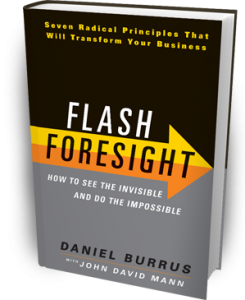 Every once in a while a book comes along that really shakes up your thinking. I recently read such a book and then had the good fortune of sitting down and talking with the author.
Every once in a while a book comes along that really shakes up your thinking. I recently read such a book and then had the good fortune of sitting down and talking with the author.
“Flash Foresight: How to See the Invisible and Do the Impossible,” by Daniel Burrus, redefines what is possible in the business world. I was so impressed after reading it that I sent Burrus an email telling him how much I enjoyed it and would enjoy chatting with him face to face. We met for a great glass of wine and had an interesting time discussing the book. Turns out we share many ideas on how business leaders can cope with today’s hyper-paced markets and high levels of uncertainty (Is it any wonder I thought he was brilliant?!)
In a nutshell, Flash Foresight presents seven principles for transforming a business:
- Start with certainty
- Anticipate
- Transform
- Take your biggest problem and skip it
- Go opposite
- Redefine and reinvent
- Direct your future
Of these, “start with certainty” is perhaps the most important as it lays the foundation for the other six principles.
Burrus proposes that although we live in a rapidly changing world, the future is not as unknowable as we think. If we look close enough, we can distinguish between cyclic change and linear change, as well as hard trends and soft trends. Armed with this information we can then determine which parts of the future we can be right about. This allows us to build our business plans based on some certainty rather than uncertainty.
What’s the difference between a hard and soft trend?
According to Burrus, a hard trend is “a projection based on measurable, tangible and fully predictable facts, events, or objects.” A soft trend is “a projection based on statistics that appear to be tangible, fully predictable facts.” A hard trend is something that will happen in the future. A soft trend is something that might happen.
For example, the fact that we have an aging population represents a hard trend. Baby Boomers will keep getting older, and nothing can stop that. Similarly, the ability to process and store more data in ever-smaller chips continues to advance at exponential rates. The ability to share information will get faster and cheaper as technology advances. These kinds of hard trends have huge implications for businesses trying to identify future market opportunities.
Flash Foresight also reinforces a concept that I constantly discuss (and even shout from the rooftops) with clients: that the way we’ve always done it is often the biggest hurdle to our future success. Accordingly, we need to constantly question our assumptions, not just about our products, services, and customers, but about everything.
For example, Burrus points out we have moved from an economy based on physical resources to one based on knowledge. This, in turn, has caused a fundamental shift in the nature of wealth and resources. When we share a physical resource with someone, our portion of that resource depletes. But when we share knowledge, it increases. As a result, it now makes more sense in many industries to collaborate rather than to compete. Which requires a very different way of thinking about how we run our companies.
Burrus and I also talked about how success often gets us stuck, because the more we know about something, the less we see that contradicts what we know. And the more success we have, the less likely we are to change, even in the face of compelling evidence that says the change is inevitable and necessary.
To counteract the human tendency to stick with what we know, Burrus suggests redefining anything and everything about our businesses. He also recommends reinventing the old by using it in new ways, such as finding new ways to use old technologies.
Another point Burrus makes that aligns with what I tell clients is the need to fail fast — to recognize failure quickly and act on it immediately. The problem with failure is not the failure itself, it’s that we tend to drag it out to the point where it holds us back from going after new opportunities. If you’re not failing at least some of the time, you’re not trying hard enough. But smart leadership requires knowing when to get off a dead horse.
I could go on and on about the book, but I don’t want to spoil it for you. If you haven’t read it, get it now and put it at the top of your reading list. You’ll find plenty of great ideas to help transform your business!






